AMD’s Radeon HD 6870 & 6850: Renewing Competition in the Mid-Range Market
by Ryan Smith on October 21, 2010 10:08 PM ESTLast but not least in our look at AMD’s new Radeon 6800 series is our look at power consumption, GPU temperatures, and the amount of noise generated. With efficiency being one of the major design goals for Barts, AMD stands to gain a lot of ground here compared to the 5800 series for only a minor drop in performance.
Looking quickly at the voltages of the 6800 series, we have 4 samples – 2 each of the 6870, and 2 each of the 6850. Both of our 6870 cards have an idle voltage of 0.945v and a load voltage of 1.172v, and seeing as how they’re both based on AMD’s reference design this is what we would expect for a design that is based around a single VID.
However our 6850 results, which include a non-reference card in the form of XFX’s customized 6850, are much more interesting. While our reference 6850 has a load voltage of 1.094v, our XFX card reports a load voltage of 1.148v. We’ll be taking a look at the XFX 6850 in-depth next week in our 6850 roundup, but for now this leaves us with the question of whether AMD is using variable VIDs, or if XFX is purposely setting theirs higher for overclocking purposes.
| Radeon HD 6800 Series Load Voltage | |||||
| Ref 6870 | XFX 6870 | Ref 6850 | XFX 6850 | ||
| 1.172v | 1.172v | 1.094v | 1.148v | ||
Finally our EVGA GTX 460 1GB FTW card has a VID of 0.975v, which compared to all the other GTX 460 cards we’ve tested thus far makes it quite notable. This is lower than any of those other cards by 0.012v, a property we believe is necessary to sell such a heavily overclocked card without causing a similarly large rise in power/heat/noise. It’s also for this reason that we question whether NVIDIA could actually supply suitable GF104 GPUs in high volumes, as GPUs capable of running at this voltage are likely coming from the cream of the crop for NVIDIA.
For our tests, please note that we do not have a pair of reference 6850s. For our second 6850 we are using XFX’s customized 6850 card, which means our results will undoubtedly differ from what a pair of true reference cards would do. However as the 6850 reference design will not be widely available this is less important than it sounds.
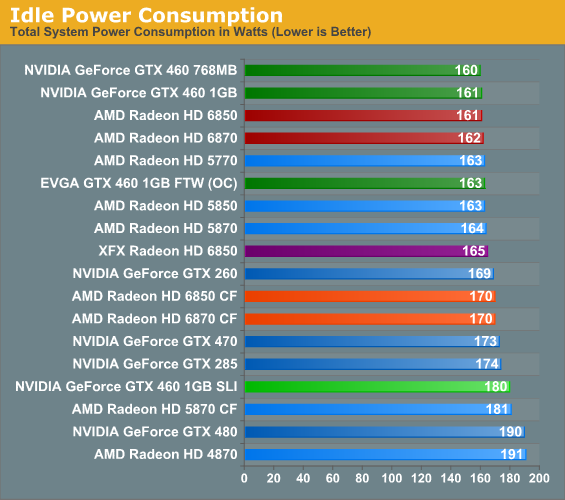
As always we start our look at power/temp/noise with our look at idle power. Because we use a 1200W PSU in our GPU test rig our PSU efficiency at idle is quite low, leading to the suppression of the actual difference between cards. But even with this kind of suppression it’s still possible to pick out what cards have a lower idle power draw, as the best cards will still result in a total system power draw that’s at least a couple of watts lower.
AMD’s official specs call for the 6800 series to have a lower idle power draw than the 5800 series, and while we can’t account for all 8 watts we do manage to shave a couple of watts off compared to our 5800 series cards. The Crossfire results are even more impressive, with the 6870CF drawing 11W less than the 5870CF.
Compared to the 6800 series the GeForce GTX 460 768MB does manage to hang on to top honor here for a single card by a watt, however in SLI our 1GB cards do worse than our 6800 series cards by 10W.
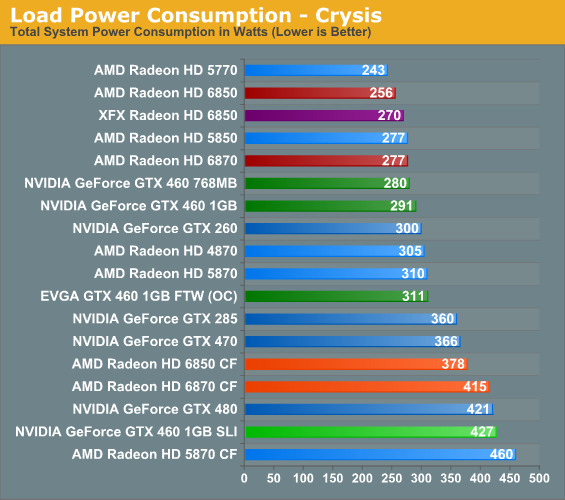
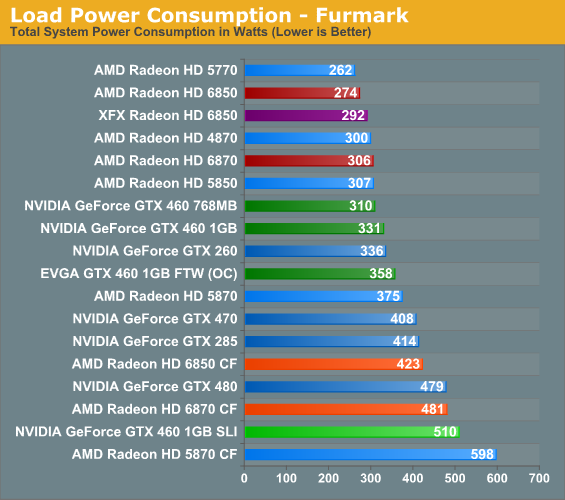
Looking at load power consumption it’s clear from the start that AMD’s efficiency gains are going to pay off here. On the latest iteration of our power consumption chart the 6850 underconsumes even the already conservative 5850 by 20W under Crysis and 25W under FurMark, showcasing how AMD was able to reduce their power consumption by a significant amount while giving up much less in the way of performance.
Compared to the 6800 series NVIDIA does notably worse here, with all of the GTX 460 cards pulling down more power than the 6870 and the GTX 470 being in a league of its own. While NVIDIA was competitive with Cypress on power, they’re not in a position to match Barts. They can deliver Barts-like performance (and then some), but they have to consume more power to do it.
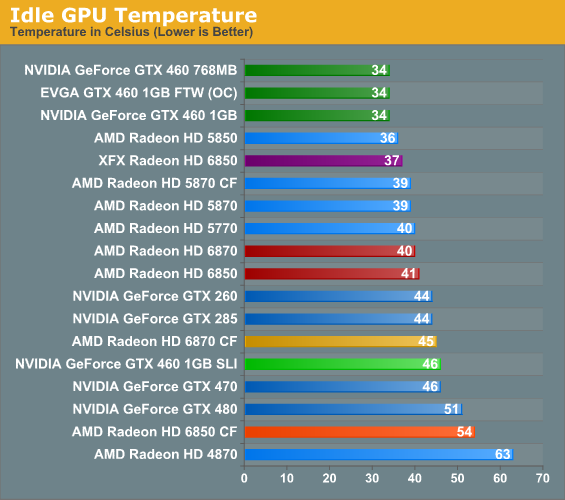
Up next is our look at GPU temperatures, starting with idle temps. As we mentioned in our GTX 460 review, NVIDIA ended up producing a very effective reference cooler for the GTX 460, utilizing an open-air design that by dissipating air inside and outside of the case is capable of reaching temperatures fully exhausting coolers can’t match. As a result all of the GTX 460 cards top our charts here.
Prior to the GTX 460 series this is a metric the 5850 always did well in, so we had expected a similar performance from the 6850, only to leave disappointed. What we’re ultimately looking at is a matter of the quality of the cooler: the 6850 may consume less power than the 5850 at idle, but it packs a weaker cooler overall, allowing it to approach these temperatures. For a gaming card such as the 6800 series idle temperatures are almost entirely superficial once we get below 50C, but even so this tells us something about the 6850 reference cooler.
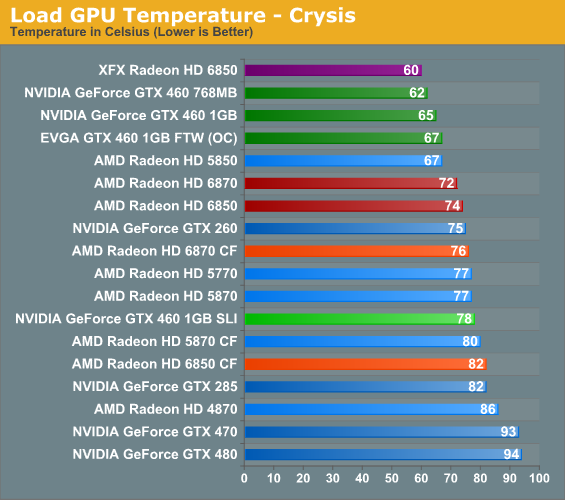
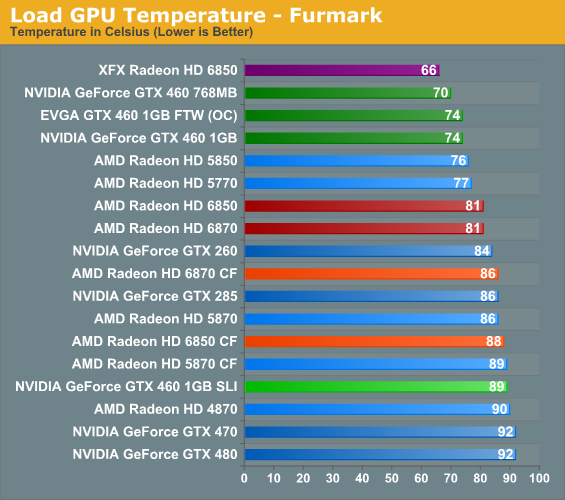
Thanks to the GTX 460’s open-air cooler, all of our GTX 460 cards top our temperature chart even with their higher power consumption. The trade-off is that all of these cards require a well-ventilated case, while the Radeon 5800 and 6800 series will tolerate much poorer cases so long as there’s enough ventilation for the card to pull in air in the first place.
As was the case with idle temperatures, the reference 6850 ends up doing worse than the 5850 here thanks to its less effective cooler; however the 6870 ends up doing better than both the 6850 and 5870 due to its more effective cooler and its lower power consumption compared to the 5870. While these cards can’t quite touch the GTX 460 series, we’re still looking at some of the coolest cards among our current benchmark suite.
Meanwhile our XFX 6850 ends up doing the best out of all of our cards here, however this will come at a cost of more noise. We'll touch on this more next week in our 6850 roundup.
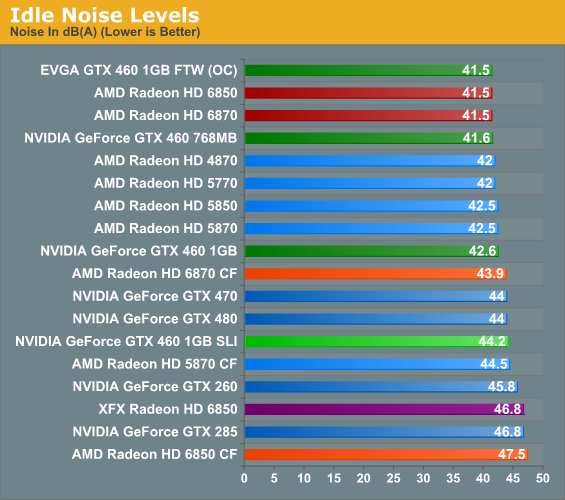
Last but not least is idle noise, which isn’t much of a story with modern cards. With the exception of the GTX 470/480, the latest GeForce and Radeon cards are both capable of running up against the noise floor of our testing environment.
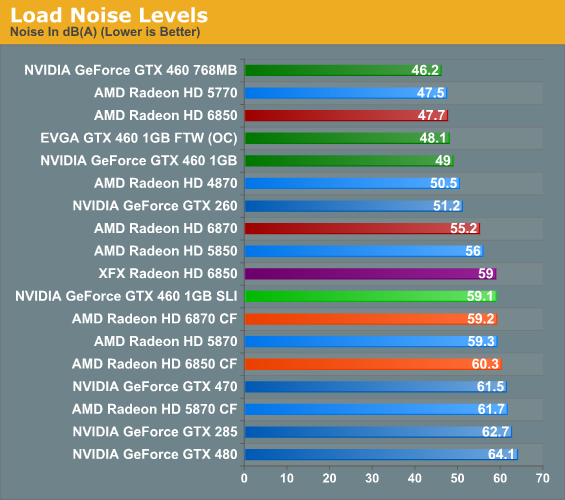
Under load we once again see an NVIDIA GTX 460 card top the chart thanks to its open-air design. This is followed very closely however by the Radeon 6850, which at 47.7dB is our third-quietest card and finally showing off the advantages of the tradeoffs AMD made with the reference cooler. The 6850 may not be as cool as the 5850, but it’s quite a bit quieter. As for the XFX card, this is where XFX has to pay the piper, as their 6850 card ends up being as loud as a 5870 in exchange for their lower temperatures.
Meanwhile the 6870 ends up being quite a bit louder than both the GTX 460 series and the 6850, coming in at 55.2dB. This is a definite leg-up compared to the 5870 and nicely cements the fact that the 6870 is intended to be the 5850’s replacement, but it means the GTX 460 series spoils the results here. Once custom-design vendor cards come out for the 6870, I suspect we’re going to see someone quickly sell a 6870 with a less aggressive cooler, which for the costs of higher temperatures would afford less noise.










197 Comments
View All Comments
campbbri - Friday, October 22, 2010 - link
Thanks for the great review. I don't know why everyone is complaining about mixing OC and Non-OC cards when you were extremely explicit in pointing it out.krumme - Friday, October 22, 2010 - link
I dont think you dont know why everyone is complaining.First. To be fair its far from everyone :), unfortunately because Anand is surrounded by far to many yes sayers. All positve. Great in many ways. But it does not develop the site as it could. There is a great huge community, and there is plenty of ressources to get ideas to new methology.
Its good - if not vital - that Kyle is explicit about it. Otherwise it wouldnt be worth critizicing, then it would just look like a payed job, and nobody would care. Its not. But beeing explicit is not enough even if its most important and a huge quality. You need to have a good case. And Anand does have a very bad case.
Read what Kyle wrote againg. Do you think this is his best and most sound decicion in his life? do he feel comfortable about it?
He did betray himself a little bit. And he shouldnt do it. He should lissen to his own doubt.
snarfbot - Friday, October 22, 2010 - link
yes i understand that, but i cant see how you can call a direct replacement that fails to outperform its predecessor as a success.especially when you consider that the prices have increased after launch as opposed to decrease as is normal. and have remained artificially high since, due to limitations at tsmc, which renders the cost argument pretty much moot.
how about an analogy.
6870 is to 5870 as 4770 is to 4870.
and its on the same process which makes it even worse, although you cant really blame amd for that.
you can very much blame their marketing department for making such a terrible decision though.
its a terrible name, thats the whole point, at whatever price you cant call it a 6870 if it cant beat a 5870.
Trefugl - Friday, October 22, 2010 - link
But the issue is that the 68xx series alone aren't really replacing the 58xx series. I think they are really splitting what the direct replacement to that market would have been into two - the 69xx (high-end enthusiast) and the 68xx (high-end mid-range).
I agree that the naming scheme isn't the best, but I think a lot of that could have been mitigated (and maybe even made a non-issue) if the 68xx's weren't the first to launch. If the 69xx came out first people would have accepted them and been happy, but instead we have b*tching because of naming confusion...
Targon - Sunday, October 24, 2010 - link
I missed this too until someone pointed out what I missed. The Radeon 6900 series will replace the 5800 series at the high end, and IS the proper high end part you are looking for.Back when DirectX 9 first came out, ATI only had DirectX 9 support in the old Radeon 9500 and 9700. When the X300, X600, and X800 came out, notice that AMD took the cards and started at 600 and 800, rather than 500 and 700 for the mid ranged and high end cards. This has continued a bit. In the HD 2000 series, you even had the HD 2900XT on the high end of the series, but then they went to the 3800, 4800, and 5800 series to mark the high end cards.
So, AMD/ATI has been tweaking the names a fair bit. What initially threw me off is that the next generation high end cards are not the first cards to show up, and we have the mid-ranged cards showing up first.
If the article said clearly, "We are reviewing the next generation mid range cards with the high generation 6900 due out next month" right up front in the article instead of buried in the text somewhere on page 2(or was it 3), there would have been less confusion.
I don't mind the change in numbers if all parts come out at the same time, but for now, there is ONLY confusion because we have yet to see the 6970.
GaMEChld - Friday, October 14, 2011 - link
I love how people are arguing over this naming change. As if people who buy discrete cards or look at video card specs don't know what their doing. If you don't know what you're buying, it serves you right.I don't know why this was so hard for people to understand. The 5700 was incredibly successful. AMD wanted to preserve that card for its performance and value. Thus, the 6700 name was taken. The 6800 model is a new model that sits BETWEEN where the 5700 and 5800 line had. If you recall, there was a MASSIVE performance gap between those lines, and AMD felt they should have something to bridge that gap.
The new 6800 line bridges that gap. It offers NEAR 5800 power at a significant price reduction.
And now ALL of the top tier cards are housed under the 6900 bracket, with the 6990 taking the dual GPU slot. If I had anything to complain about its the abandonment of the X2 designation on dual GPU cards.
In fact, the only thing people should be angry about is the fact that the 6700 is virtually identical to the 5700 and offers little performance advantage. THAT is what is reminiscent of the 8800GT -> 9800GT transition. However, since the 5700 was a midrange product, maybe it received less attention than it should have.
DanaG - Friday, October 22, 2010 - link
Now, if the 6870 is what should've been a 6770, and a 6970 is what should've been a 6870... then what'll they call what should've been a 6970? 6-10-70 / 6ten70? 6X70? 6999? Or will they go to 6970 X2?spigzone - Saturday, October 23, 2010 - link
6990 ... yhat wasn't so hard now, was it?AMD_Pitbull - Saturday, October 23, 2010 - link
Gotta say, I agree 100%. I really don't understand why everyone is getting so bloody upset with this. New product, new line. You couldn't predict what was going to happen? Sorry. Companies like to keep people guessing.Also, if you really want to get technical, this 6870 DOES beat the 5870 if a few things as well. Overall greater effective product AND cheaper? Win in my books. Sorry QQ'ers.
dvijaydev46 - Saturday, October 23, 2010 - link
I tried converting a video file using my 5770 Hawk with MediaEspresso 6 (with hardware acceleration enabled of course), I wasn't impressed but Mediashow 5 properly utilized the GPU power and the speed difference in converting was clear. I'm not sure if there was a problem in the installation of my copy of MediaEspresso 6, but I think you guys can use Mediashow 5 to see if there is any difference in video conversion time with an AMD GPU as I don't have any other card.